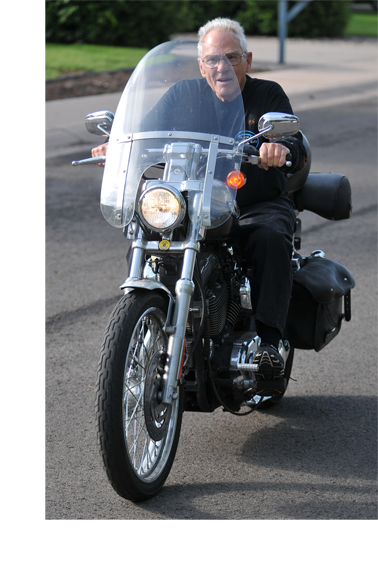
|
At the start of my academic career, and well into my work career, there wasn't enough money to cover my needs and a motorcycle. But the day came in 1963 when I arrived in Laramie as Dean of the University of Wyoming College of Arts and Sciences. I was able to buy a 150cc kick-start Kawasaki. Prior to that I had graduated (1940) from Carnegie Tech (now Carnegie Mellon University) and started graduate school. However, WWII caused a change of plans and I ended up in the US Navy. Actually this was a good experience (although it didn't seem so at the time), and provided lifetime benefits. The first was the GI Bill which helped immensely in my returning to graduate school and finishing my Ph.D. at the University of New Mexico in 1950. Having remained in the active reserve (by necessity while in graduate school), I was not only able to add a few dollars to the bank account, but with 20 years of active and reserve duty I was “retired”, and hence became eligible for a pension and medical services. The latter was a great boon as the girl I met at Carnegie Tech and married acquired a lengthy and terminal illness in her later life. Then there were the ten years at New Mexico Highlands University where I was much too busy (and too poor with a new family) for a bike. But those years were most valuable in that I learned not only how to initiate my own research program, but later how to administer a research institute and a graduate school. I also learned how to build campus buildings, and this proved to be the key to my being hired at the University of Wyoming. At UW, I finally got the bike and it surely was important in coping. In 1963, UW was a very small state university (about 5000 enrollment) that, frankly, had to be near the bottom of state and land grant universities. The Arts and Sciences college in particular was overworked, had grossly inadequate facilities, and little character of its own. The campus filling station I called it, as its primary duty was to offer courses needed by the other colleges: agriculture, business, education, engineering, and health sciences. Despite generating about 65% of the student credit hours, the faculty numbered about 100. It took 15 years and many headaches (and lots of bike rides) to build the Science Center, the Fine Arts Building, and obtain and remodel buildings for the Humanities, the Social Sciences, and the new department of Computer Science. More headaches and more bike rides were needed to increase the faculty to 300 with quality people. Still more headaches and bike rides were needed to develop solid bachelor, master, and doctoral programs. At the end of this time I was promoted (actually demoted, as there is no better a job in a multi-purpose university than Dean of Arts and Sciences) to Vice President for Research, a position that did not exist. To establish the University Research Office involved more headaches and more bike rides, but, as with building Arts and Sciences, it was most rewarding. Then, of course, 1990 arrived and it was time to retire. But fortunately retirement meant moving on to other things. It meant a campus office with fund raising, committee service, and “advisory” duties. It meant more time for important organizations such as the American Institute of Chemists (50 years) and the American Chemical Society (75 years). It meant time to participate in civic activities, such as serving on the City Council and the Airport Board, and being involved with the Chamber of Commerce, the City Museum, the State Territorial Park, etc. And, of course, I had meant more time to ride the bike...to visit Sturgis, to attend the Harley Davidson 100th anniversary in Milwaukee, to ride through Alaska, and to enjoy nature. But that too came to an end two years ago (sold the bike) with the realization that nothing, regardless of how bad or good, lasts forever. It has been a wonderful ride.
|
|||||||||||||
